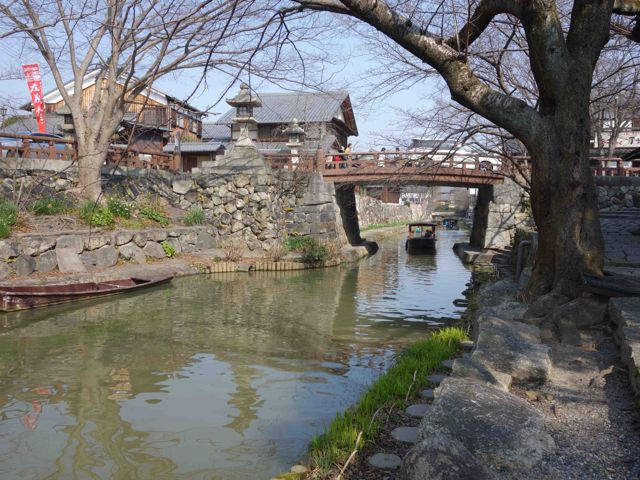ゲストブログ (ジョンさん) 近江八幡でのエッセイ(言葉のスケッチ)

原文をそのままアップロードします。何度も翻訳を試みましたが、原文のニュアンスを日本語で表すのは難しいことがよくわかりました。本人は「エッセイ」を書いたと言っていますが、読んでみると「詩」のようです。個性的な英語の文章を訳すのは難しいです。科学技術英語には慣れているつもりですが、この文章は文学的で、それとはまるで別物です。
中学校の国語の時間に習った上田 敏(うえだ びん)の訳詩集「海潮音」の中の詩を思い出しました。
山のあなたの空遠く
「幸(さいはひ)」住むと人のいふ。
ああ、われひとと尋(と)めゆきて、
涙さしぐみ、かへりきぬ。
山のあなたになほ遠く
「幸(さいはひ)」住むと人のいふ。
(カール・ブッセ)
日本人の誰もが口にする名訳です。もう日本人の詩になっていて、全く違和感がありません。考えてみたらすごいことです。
下の英文の日本語訳を見たい方は、「Google 翻訳」や「Excite 翻訳」などを使ってみてください。文章の内容をざっとたどることはできます。

Ohmihachiman, 28thFebruary, 2016, 13:30–14:50
Unedited essay byJon
Allure of a risingsun
Modern rhythms.Curves. If one can make any particular image of Japan, it is always thejuxtaposition between the two. But just how modern? Often one senses the curvesas but ripples in the scene. Tantalisingly static, rich moments. The bridge,lanterns, river traffic; one fleeting moment the age of Edo presents, the next,broken, intruded upon by our times, of visitors, all clamouring to enjoy thesame apparition of times past.
Ripples. The watershimmers. A rich muddy green transposed against the reflected myriad of cars,the young, old, all subjects and objects of our consumeristic times. In frontwe spy the fevered artist. Quick stuttering pencil lines are calmed by thesweeping strokes for bridge, bank, boat. No reflection of him, for him.Perspective denies. But not entirely. Time brings with it new interventions ofinterested bystanders, some linger, others glance. None yet dared to challengehis serenity in concentration. Who will be the first?
A full sun saturatesour moment together. The flags are brought to the fore and waning daffodilsacross the course are brought briefly into life once more. Glinting cars nowbring their beat to the emerging sketch, too ephemeral to become fixed by hisfine-lining pen, just a third into this early afternoon hour.
Still nobody dare?Many pause to observe, a few seconds; others sit at the nearby caf?’s stonetable, a few minutes. Strangely no birds make themselves obvious. Runningchildren hop across the bank’s round stones below, laid out as a path for theintrepid, with the canal touching them in sunken parts. Distant sirens breakthe rhythm. Delivery van doors. All servicing the passers-by.
Should not abackdrop to everything be a typically blue sky? Even here this need not besimple. It is not a rich blue, but tinged with a light haze, lending this sceneof our bridge a subtle bright gradient that strengthens further under itsarches to emphasise tiny patches of chaotic shimmers. These require a fourthboat to pass and spear them, until again their return.
Ah! Black crowsearching. Leaves a-turning. Like the children, hopping from stone to stone forhis opportunity. A sudden swoop, low down the middle of the canal, gone for buta minute to return, in the same fashion, to watch us, the tourists, from abovethe red banners.
Fever returns.Flashing water. This time it is coloured and the once silent sweeping MountainBase, is dabbing, streaking, infecting more determined pauses from our quieterand more focused friends. Camera shutters cry! Three, four times. Two serious,too burdened, photographers take up position. Now two thirds into the visit,the stalking has begun. Purples and yellow blister and blur the WaterfordWhite. Made in England. Written in Japan. Sketched into Wonder.
This rhythmstaccatos as frame after frame burns us removed creations onto albums destinedfor deletion or eternal online posterity. Our stalkers declined to interjectand determine the outcome. I find courage to turn. They are gone. Replaced by asurprised young family and curly ice-cream. I moved too quickly, punctuatingthe soft expectation of remoteness.
Yet another boatswirls and gurgles by, followed, in its wake, by a tour, led by a determinedlady guide with a strong, unwavering, patter of, I assume, Japanese facts,history, a break-beat crossing the time.
Faint fragrantincense. Alone again, briefly, before a couple nods, she hums in admiration,passing quite quickly. The air feels crisper. The caf? owner appears at his stonetable behind. The snap of his lighter and the incense withdraws, subservient tohis lit cigarette.
Three charmingladies view his menu, discuss, then turn and murmurs of observation are heard.Our artist tends his almost complete moment, the curves slowing. Little extrasbring polish and emphasis. After this hour of concentration my left hand aches,satisfied that it has been part of at least the present rhythm, observing theHachiman sketch.
In the last moment,finally we have a “sugoi”! The lady speaks. The caf? owner? A grin, a snap ofhis lighter. More customers.